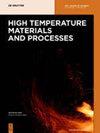A novel method for CO2 injection direct smelting vanadium steel: Dephosphorization and vanadium retention
IF 1.6
4区 材料科学
Q4 MATERIALS SCIENCE, MULTIDISCIPLINARY
引用次数: 0
Abstract
Abstract A novel method for CO2 injection direct smelting vanadium steel (CIDSVS) is proposed. Achieving selective oxidation of phosphorus is essential for the applicability of the suggested process. Under the guidance of thermodynamics, the mechanisms of CO2 injection dephosphorization and vanadium retention were investigated with CO2 flow rate and dephosphorization slag composition as experimental variables. The results indicate that CO2 as an oxygen source can remove 73.8% of phosphorus, while the oxidation rate of vanadium is 17.5%. The dephosphorization process can be divided into two stages: FeO- and CO2-dominated experimental processes. In the initial stage of slag feeding, [V] and [P] undergo fast oxidation, and the oxidation amount is positively correlated with the initial FeO content. The high basicity (CaO/SiO2 ratio) reduces the activity of V2O3 in the slag and promotes the oxidation of [V]. Under the experimental conditions of 1,400°C, the optimal conditions were determined to be a CO2 flow rate of 1.5 mL·g−1·min−1, a FeO content of 40%, and a basicity B of 2.5. Following the CIDSVS steelmaking operation, 80% of the vanadium is retained, and the impurity elements fulfill the specifications for steel. This method enhances vanadium utilization and is environmentally friendly.CO2喷射直接冶炼钒钢的一种新方法:脱磷留钒
摘要提出了一种新的CO2喷射直接熔炼钒钢的方法。实现磷的选择性氧化对于所建议的工艺的适用性至关重要。在热力学的指导下,以CO2流量和脱磷渣成分为实验变量,研究了CO2喷射脱磷和钒保留的机理。结果表明,CO2作为氧源可以去除73.8%的磷,而钒的氧化率为17.5%。脱磷过程可分为两个阶段:FeO-和CO2为主的实验过程。在入渣初期,[V]和[P]发生快速氧化,氧化量与初始FeO含量呈正相关。高碱度(CaO/SiO2比)降低了炉渣中V2O3的活性,促进了[V]的氧化。在1400°C的实验条件下,确定最佳条件为CO2流速为1.5 mL·g−1·min−1,FeO含量为40%,碱度B为2.5。CIDSVS炼钢操作后,保留了80%的钒,杂质元素符合钢的规范。这种方法提高了钒的利用率并且对环境友好。
本文章由计算机程序翻译,如有差异,请以英文原文为准。
求助全文
约1分钟内获得全文
求助全文
来源期刊

High Temperature Materials and Processes
工程技术-材料科学:综合
CiteScore
2.50
自引率
0.00%
发文量
42
审稿时长
3.9 months
期刊介绍:
High Temperature Materials and Processes offers an international publication forum for new ideas, insights and results related to high-temperature materials and processes in science and technology. The journal publishes original research papers and short communications addressing topics at the forefront of high-temperature materials research including processing of various materials at high temperatures. Occasionally, reviews of a specific topic are included. The journal also publishes special issues featuring ongoing research programs as well as symposia of high-temperature materials and processes, and other related research activities.
Emphasis is placed on the multi-disciplinary nature of high-temperature materials and processes for various materials in a variety of states. Such a nature of the journal will help readers who wish to become acquainted with related subjects by obtaining information of various aspects of high-temperature materials research. The increasing spread of information on these subjects will also help to shed light on relevant topics of high-temperature materials and processes outside of readers’ own core specialties.
 求助内容:
求助内容: 应助结果提醒方式:
应助结果提醒方式:


